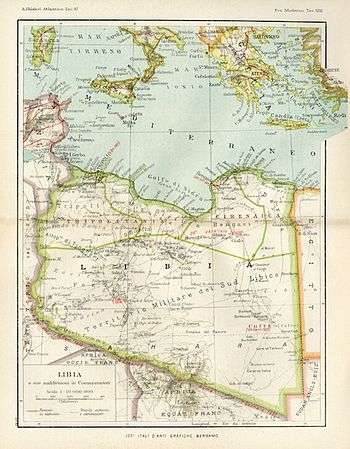Italian colonization of Libya
Italian colonization of Libya began in 1911 and lasted until 1943. The country, previously an Ottoman possession, was occupied by Italy in 1911 after the Italo-Turkish War, which resulted in the establishment of two colonies: Italian Tripolitania and Italian Cyrenaica. In 1934, they were unified in the colony of Italian Libya. In 1937 this colony was divided into four provinces, and in 1939 the coastal provinces became part of metropolitan Italy. The colonization lasted until Libya's occupation by Allied forces in 1943, though it was not until the 1947 Paris Peace Treaty that Italy officially renounced all claims to Libyan territory.
| Italian Tripolitania & Cyrenaica | 1911–1934 |
|---|---|
| Italian Libya | 1934-1943 |
Part of a series on the |
||||||||||||||||||||||||||||||||||||
|---|---|---|---|---|---|---|---|---|---|---|---|---|---|---|---|---|---|---|---|---|---|---|---|---|---|---|---|---|---|---|---|---|---|---|---|---|
| History of Libya | ||||||||||||||||||||||||||||||||||||
|
||||||||||||||||||||||||||||||||||||
|
| ||||||||||||||||||||||||||||||||||||
Italian Tripolitania and Cyrenaica (1911-1934)
First years
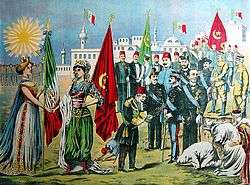

On 3 October 1911, Italy attacked Tripoli, claiming to be liberating the Ottoman Wilayats from Istanbul's rule
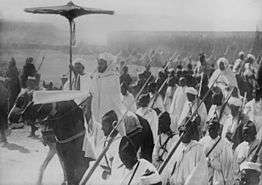

Despite a major revolt by the Arabs, the Ottoman sultan ceded Libya to the Italians by signing the 1912 Treaty of Lausanne (not to be confused with a more famous treaty of the same name made in 1923). The Italians made extensive use of the Savari, colonial cavalry troops raised in December 1912. These units were recruited from the Arab-Berber population of Libya following the initial Italian occupation in 1911–12. The Savari, like the Spahi or mounted Libyan police, formed part of the Regio Corpo Truppe Coloniali della Libia (Royal Corps of Libyan Colonial Troops). Tripoli was largely under Italian control by 1914, but both Cyrenaica and the Fezzan were home to rebellions led by the nomadic Senussi.
Sheikh Sidi Idris al-Mahdi as-Senussi (later King Idris I), of the Senussi, led Libyan resistance in various forms through the outbreak of the Second World War. After the Italian army invaded Cyrenaica in 1913 as part of their wider invasion of Libya, the Senussi Order fought back against them.[1] When the Order's leader, Ahmed Sharif as-Senussi, abdicated his position, he was replaced by Idris, who was his cousin.[2] Pressured to do so by the Ottoman Empire, Ahmed had pursued armed attacks against British military forces stationed in neighbouring Egypt. On taking power, Idris put a stop to these attacks.[2]
Instead he established a tacit alliance with the British, which would last for half a century and accord his Order de facto diplomatic status.[3] Using the British as intermediaries, Idris led the Order into negotiations with the Italians in July 1916.[4] These resulted in two agreements, Al-Zuwaytina in April 1916 and Akrama in April 1917.[5] The latter of these treaties left most of inland Cyrenaica under the control of the Senussi Order [2] Relations between the Senussi Order and the newly established Tripolitanian Republic were acrimonious.[3] The Senussi attempted to militarily extend their power into eastern Tripolitania, resulting in a pitched battle at Bani Walid in which the Senussi were forced to withdraw back into Cyrenaica.[2]
At the end of World War I, the Ottoman Empire signed an armistice agreement in which they ceded their claims over Libya to Italy.[6] Italy however was facing serious economic, social, and political problems domestically, and was not prepared to re-launch its military activities in Libya.[6] It issued statutes known as the Legge Fondamentale with both the Tripolitanian Republic in June 1919 and Cyrenaica in October 1919. These brought about a compromise by which all Libyans were accorded the right to a joint Libyan-Italian citizenship while each province was to have its own parliament and governing council.[6] The Senussi were largely happy with this arrangement and Idris visited Rome as part of the celebrations to mark the promulgation of the settlement.[6]

In October 1920, further negotiations between Italy and Cyrenaica resulted in the Accord of al-Rajma, in which Idris was given the title of the Emir of Cyrenaica and permitted to autonomously administer the oases around Kufra, Jalu, Jaghbub, Awjila, and Ajdabiya. As part of the Accord he was given a monthly stipend by the Italian government, who agreed to take responsibility for policing and administration of areas under Senussi control.[6] The Accord also stipulated that Idris must fulfill the requirements of the Legge Fondamentale by disbanding the Cyrenaican military units, however he did not comply with this.[6] By the end of 1921, relations between the Senussi Order and the Italian government had again deteriorated.[6]
In October 1920, further negotiations between Italy and Cyrenaica resulted in the Accord of al-Rajma, in which Idris was given the title of the Emir of Cyrenaica and permitted to autonomously administer the oases around Kufra, Jalu, Jaghbub, Awjila, and Ajdabiya. As part of the Accord he was given a monthly stipend by the Italian government, who agreed to take responsibility for policing and administration of areas under Senussi control.[6] The Accord also stipulated that Idris must fulfill the requirements of the Legge Fondamentale by disbanding the Cyrenaican military units, however he did not comply with this.[6] By the end of 1921, relations between the Senussi Order and the Italian government had again deteriorated.[6]
Following the death of Tripolitanian leader Ramadan Asswehly in August 1920, the Republic descended into civil war. Many tribal leaders in the region recognised that this discord was weakening the region's chances of attaining full autonomy from Italy, and in November 1920 they met in Gharyan to bring an end to the violence.[7] In January 1922 they agreed to request that Idris extend the Sanui Emirate of Cyrenaica into Tripolitania in order to bring stability; they presented a formal document with this request on 28 July 1922.[7] Idris' advisers were divided on whether he should accept the offer or not. Doing so would contravene the al-Rajma Agreement and would damage relations with the Italian government, who opposed the political unification of Cyrenaica and Tripolitania as being against their interests.[7] Nevertheless, in November 1922 Idris agreed to the proposal.[7] Following the agreement, Idris feared that Italy — under its new Fascist leader Benito Mussolini—would militarily retaliate against the Senussi Order, and so he went into exile in Egypt in December 1922.[8]
The "Pacification Campaign"
Fighting intensified after the accession to power in Italy of the dictator Benito Mussolini. Due to the effective resistance of the Libyan people against Italy's so-called "pacification campaign", Italian colonization of the Ottoman provinces of Tripolitania and Cyrenaica was not initially successful and it was not until the early 1930s that the Kingdom of Italy took full control of the area.[9]

Several reorganizations of the colonial authority had been made necessary because of armed Arab opposition, mainly in Cyrenaica. Between 1919 (17 May) to 1929 (24 January), the Italian government maintained the two traditional provinces, with separate colonial administrations. A system of controlled local assemblies with limited local authority was set up, but was revoked on 9 March 1927.In 1929, Tripoli and Cyrenaica were united as one colonial province. From 1931 to 1932, Italian forces under General Badoglio waged a punitive pacification campaign. Badoglio's successor in the field, General Rodolfo Graziani, accepted the commission from Mussolini on the condition that he was allowed to crush Libyan resistance unencumbered by the restraints of either Italian or international law. Mussolini reportedly agreed immediately and Graziani intensified the oppression.
Some Libyans continued to defend themselves, with the strongest voices of dissent coming from the Cyrenaica. Beginning in the first days of Italian colonization, Omar Mukhtar, a Senussi sheikh, organized and, for nearly twenty years, led Libyan resistance efforts. His example continued to inspire resistance even after his capture and execution on 16 September 1931. His face is currently printed on the Libyan ten dinar note in memory and recognition of his patriotism.

After a much-disputed truce, the Italian policy in Libya reached the level of full-scale war in 1932. A barbed wire fence was built from the Mediterranean to the oasis of Jaghbub to sever lines critical to the resistance. Soon afterwards, the colonial administration began the wholesale deportation of the people of the Jebel Akhdar to deny the resistance the support of the local population. The forced migration of more than 100,000 people ended in concentration camps in Suluq and El Agheila, where thousands died in squalid conditions. It is estimated that the number of Libyans who died, killed in the fighting or through starvation and disease is a minimum of 80,000 people, up to one third of the Cyrenaican population.[10]
Italy committed major war crimes during the conflict, including the use of illegal chemical weapons, episodes of refusing to take prisoners of war and instead executing surrendering combatants, and mass executions of civilians.[11] Italian authorities committed ethnic cleansing by forcibly expelling 100,000 Bedouin Cyrenaicans, almost half the population of Cyrenaica, from their settlements, slated to be given to Italian settlers.[12][13] Other war crimes to committed by the Italian armed forces against civilians include deliberate bombing of civilians, killing unarmed children, women, and the elderly, rape and disembowelment of women, throwing prisoners out of aircraft to their death and running over others with tanks, regular daily executions of civilians in some areas, and bombing tribal villages with mustard gas bombs beginning in 1930.[14] The Italian occupation also reduced the number of livestock by killing, confiscation or driving the animals from their pastoral land to inhospitable land near the concentration camps.[15] The number of sheep fell from 810,000 in 1926 to 98,000 in 1933, goats from 70,000 to 25,000 and camels from 75,000 to 2,000.[15]
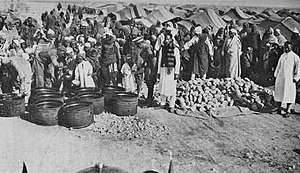
From 1930 to 1931, 12,000 Cyrenaicans were executed and all the nomadic peoples of northern Cyrenaica were forcefully removed from the region and relocated to huge concentration camps in the Cyrenaican lowlands.[16] Propaganda by the Fascist regime declared the camps to be oases of modern civilization that were hygienic and efficiently run –– however in reality the camps had poor sanitary conditions as the camps had an average of about 20,000 inmates, together with their camels and other animals, crowded into an area of one square kilometer.[17] The camps held only rudimentary medical services, with the camps of Soluch and Sisi Ahmed el Magrun with an estimated 33,000 internees having only one doctor between them.[17] Typhus and other diseases spread rapidly in the camps as the people were physically weakened by meagre food rations provided to them and forced labor.[17] By the time the camps closed in September 1933, 40,000 of the 100,000 total internees had died in the camps.[17]
By 1934, Libyan indigenous resistance was effectively crushed. The new Italian governor Italo Balbo created the political entity called Italian Libya in the summer of that year.[18] The classical name "Libya" was revived as the official name of the unified colony. Then in 1937 the colony was split administratively into four provinces: Tripoli, Misrata, Benghazi, and Derna. The Fezzan area was called Territorio Sahara Libico and administered militarily.
Italian Libya (1934-1943)

In March 1937 Mussolini made a state visit to Libya, where he opened a new military highway running the entire length of the colony (the Via Balbia). For propaganda reasons he had himself declared Protector of Islam and was presented with a symbolic sword. Mussolini's publicized encouragement of the Arab nationalist movement suited his wider policies of confronting Britain and France. He also sought to fully colonize Libya, introducing 30,000 Italian colonists which brought their numbers to more than 100,000. These colonists were shipped primarily to Sahel al-Jefara in Tripolitania and the Jebel Akhdar in Cyrenaica, and given land from which the indigenous inhabitants had been partially removed during the colonial war in the 1920s.[19] At the time of the 1939 census, the Italian population in Libya numbered 108,419 (12.37% of the total population), concentrated on the coast around the city of Tripoli (37% of the city's population) and Benghazi (31%). The 22,000 Libyan Jews were allowed to integrate in the society of the "Fourth Shore (but after summer 1941, with the arrival of the German Afrika Korps, they started to be moved to internment camps under Nazi SS control).
On January 9, 1939, the colony was incorporated into metropolitan Italy and thereafter considered by Italy to be an integral part of their state. By 1939, the Italians had built 400 km of new railroads and 4,000 km of new roads. During World War II a new road was still being built, the Via della Vittoria, and a new Tripoli-Benghazi railway. On 13 September 1940, Mussolini's highway was used for the invasion of Egypt by Italian forces stationed in Libya.[20]
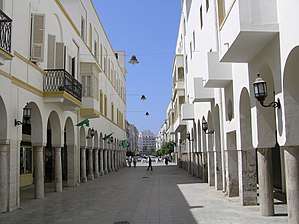
In 1939, laws were passed that allowed Muslims to be permitted to join the National Fascist Party and in particular the Muslim Association of the Lictor (Associazione Musulmana del Littorio). These reforms allowed the creation of Libyan military units within the Italian army (with 30,000 native Muslim soldiers).[21] Two divisions of Libyan colonial troops were created (1 Libyan Division Sibelle and 2 Libyan Division Pescatori), and in the summer of 1940 both participated in the Italian offensive against the British army in Egypt [22]). Even a battalion of Libyan paratroopers[23] was raised shortly before World War II, the first force of this kind to be created in all Africa. Other Libyan troops had been fighting for the Kingdom of Italy since the 1920s: the Savari (cavalry regiments) and the Spahi (mounted police).
Mussolini sought to assimilate the Arabs of Libya (whom he called "Muslim Italians") and so in 1939 ten villages were created for Arabs and Berbers: "El Fager" (It. Alba, En. Dawn), "Nahima" (It. Deliziosa, En. Delicious), "Azizia" (It. Profumata, En. Perfumed), "Nahiba" (It. Risorta, En. Risen), "Mansura" (It. Vittoriosa, En. Victorious), "Chadra" (It. Verde, En. Green), "Zahara" (It. Fiorita, En. Blossomed), "Gedina" (It. Nuova, En. New), "Mamhura" (It. Fiorente, En. Flourished), "El Beida" (It. La Bianca, En. White). All these new villages had their mosque, school, social centre (with sport grounds and cinema) and small hospital. This was purportedly a reward for the military performance of the Libyan colonial troops: in 1936 Savaris and other Libyan units took part in the Italian invasion of Ethiopia and received a "Gold Medal of Honour" for their distinguished performance in battle. [24]
 The Royal Palace of Tripoli
The Royal Palace of Tripoli- Berenice Hotel
 Suk el Turk market, 1935
Suk el Turk market, 1935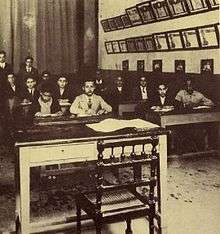 Benghazi Jews in synagogue classroom (1939)
Benghazi Jews in synagogue classroom (1939)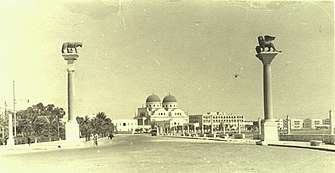 The Catholic Cathedral was connected to the "Via Vittoria", that had two columns featuring the Lion of Venice and the Capitoline Wolf
The Catholic Cathedral was connected to the "Via Vittoria", that had two columns featuring the Lion of Venice and the Capitoline Wolf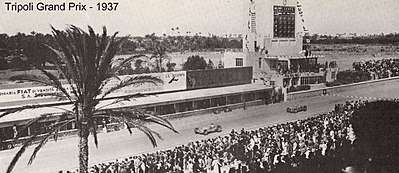 1937 Tripoli Grand Prix
1937 Tripoli Grand Prix Roman theatre of Sabratha, restored during the Italian rule.
Roman theatre of Sabratha, restored during the Italian rule.
Decolonization
From 1943 to 1951, Libya was under Allied occupation. The British military administered the two former Italian Libyan provinces of Tripolitana and Cyrenaïca, while the French administered the province of Fezzan.
Under the terms of the 1947 peace treaty with the Allies, Italy, which hoped to maintain the colony of Tripolitania, (and France, which wanted the Fezzan), relinquished all claims to Libya. Libya remained united as it experienced the process of decolonization that characterized colonies of Europe in the mid-Twentieth Century.
In July 1998, the Italian government offered a formal apology to Libya. In August 2008 the two nations signed a treaty of friendship in which US$5 billion in goods and services, including the construction of the Libyan portion of the Cairo-Tunis highway, would be given to Libya to end any remaining animosity.[25][26][27] In exchange, Libya would take measures to combat illegal immigration coming from its shores and boost investments in Italian companies.[26][28] The treaty was ratified by Italy on 6 February 2009,[25] and by Libya on 2 March, during a visit to Tripoli by Silvio Berlusconi, who recognized historic atrocities and repression committed by the state of Italy against the Libyan people during colonial rule, stating: "In this historic document, Italy apologizes for its killing, destruction and repression of the Libyan people during the period of colonial rule." and went on to say that this was a "complete and moral acknowledgement of the damage inflicted on Libya by Italy during the colonial era".[29]
Cooperation ended in February 2011 as a result of the Libyan Civil War which overthrew Gaddafi. On 26 September 2011, Italian energy company Eni announced it had restarted oil production in Libya for the first time since the start of the 2011 Libyan civil war. The quick return of Eni to Libyan oilfields reflected the positive relations between Rome and Tripoli.[30] The Italian embassy in Tripoli is one of the few Western embassies still active in Libya during the Post-civil war violence in Libya, due the fact that Italy is the most important trade partner for Libya.[31][32]
See also
- List of colonial heads of Libya
- Italian Libya, 1934–1943
- Fourth Shore
- Italo Balbo
- Italy–Libya relations
- Savari
- Spahi
- Italian Libyan Colonial Division
- Tripoli Grand Prix
- Italian Empire
- Via Balbia
- Via della Vittoria
- Italian Libya Railways
- Aouzou Strip
Notes
- Vandewalle 2006, p. 26.
- Bearman 1986, p. 14; Vandewalle 2006, p. 27.
- Vandewalle 2006, p. 27.
- Vandewalle 2006, p. 27; Bruce St. John 2012, p. 66.
- Vandewalle 2006, p. 27; Bruce St. John 2012, pp. 66–67.
- Vandewalle 2006, p. 28.
- Vandewalle 2006, p. 29.
- Bearman 1986, pp. 14–15; Vandewalle 2006, p. 29.
- Chapin Metz, Hellen. Libya: A Country Study. First Chapter
- Mann, Michael (2006). The dark side of democracy: explaining ethnic cleansing (2nd ed.). Cambridge, England: Cambridge University Press. p. 309.
- Duggan 2007, p. 497
- Cardoza, Anthony L. (2006). Benito Mussolini: the first fascist. Pearson Longman. p. 109.
- Bloxham, Donald; Moses, A. Dirk (2010). The Oxford Handbook of Genocide Studies. Oxford, England: Oxford University Press. p. 358.
- Geoff Simons, Tam Dalyell (British Member of Parliament, forward introduction). Libya: the struggle for survival. St. Martin's Press, 1996. 1996 Pp. 129.
- General History of Africa, Albert Adu Boahen,Unesco. International Scientific Committee for the Drafting of a General History of Africa, page 196, 1990
- Wright, John (1983). Libya: A Modern History. Kent, England: Croom Helm. p. 35.
- Duggan, Christopher (2007). The Force of Destiny: A History of Italy Since 1796. New York: Houghton Mifflin. p. 496.
- Helen Chapin Metz wrote in her book Libya: A Country Study: Once pacification had been accomplished, fascist Italy endeavoured to convert Libya into an Italian province to be referred to popularly as Italy's Fourth Shore. In 1934 Tripolitania and Cyrenaica were divided into four provinces—Tripoli, Misrata, Benghazi, and Darnah—which were formally linked as a single colony known as Libya, thus officially resurrecting the name that Diocletian had applied nearly 1,500 years earlier. Fezzan, designated as South Tripolitania, remained a military territory. A governor general, called the first consul after 1937, was in overall direction of the colony, assisted by the General Consultative Council, on which Arabs were represented. Traditional tribal councils, formerly sanctioned by the Italian administration, were abolished, and all local officials were thereafter appointed by the governor general. Administrative posts at all levels were held by Italians.An accord with Britain and Egypt obtained the transfer of a corner of the Anglo-Egyptian Sudan, known as the Sarra Triangle, to Italian control in 1934. The next year, a French-Italian agreement was negotiated that relocated the 1,000-kilometer border between Libya and Chad southward about 100 kilometers across the Aouzou Strip, but this territorial concession to Italy was never ratified by the French legislature. In 1939 Libya was incorporated into metropolitan Italy. During the 1930s, impressive strides were made in improving the country's economic and transportation infrastructure. Italy invested capital and technology in public works projects, extension and modernization of cities, highway and railroad construction, expanded port facilities, and irrigation, but these measures were introduced to benefit the Italian-controlled modern sector of the economy. Italian development policy after World War I had called for capital-intensive "economic colonization" intended to promote the maximum exploitation of the resources available. One of the initial Italian objectives in Libya, however, had been the relief of overpopulation and unemployment in Italy through emigration to the undeveloped colony. With security established, systematic "demographic colonization" was encouraged by Mussolini's government. A project initiated by Libya's governor, Italo Balbo, brought the first 20,000 settlers--the ventimilli--to Libya in a single convoy in October 1938. More settlers followed in 1939, and by 1940 there were approximately 110,000 Italians in Libya, constituting about 12 percent of the total population. Plans envisioned an Italian colony of 500,000 settlers by the 1960s. Libya's best land was allocated to the settlers to be brought under productive cultivation, primarily in olive groves. Settlement was directed by a state corporation, the Libyan Colonization Society, which undertook land reclamation and the building of model villages and offered a grubstake and credit facilities to the settlers it had sponsored. The Italians made modern medical care available for the first time in Libya, improved sanitary conditions in the towns, and undertook to replenish the herds and flocks that had been depleted during the war. But, although Mussolini liked to refer to the Libyans as "Muslim Italians," little more was accomplished that directly improved the living standards of the Arab population.
- New villages in coastal Libya (in Italian) Archived 2011-07-20 at the Wayback Machine
- They trained in Castel Benito]], near Tripoli, where the first "Italian Military Parachute School" was located (the first troops trained were two Libyan battalions, the Libyan Parachute Battalion and the 1st National Libyan Parachute Battalion,of the Regio Corpo Truppe Coloniali della Libia (Royal Colonial Corps). Counter-attacks of British Allied forces from Egypt, commanded by Wavell and their successful two-month campaign in (Tobruk, Benghazi, El Agheila), and the counter-offensives under Erwin Rommel in 1940-43, all took place during World War II. In November 1942, the Allied forces retook Cyrenaica; by February 1943, the last German and Italian soldiers were driven from Libya. In the early post-war period, Tripolitania and Cyrenaica remained under British administration, while the French controlled Fezzan. In 1944, Idris returned from exile in Cairo but declined to resume permanent residence in Cyrenaica until the removal in 1947 of some aspects of foreign control
- Sarti, p196.
- 30,000 Libyans fought for Italy in World War II
- Libyan Paratroopers
- Medal of Military Honor
- "Ratifica ed esecuzione del Trattato di amicizia, partenariato e cooperazione tra la Repubblica italiana e la Grande Giamahiria araba libica popolare socialista, fatto a Bengasi il 30 agosto 2008". Parliament of Italy. 2009-02-06. Archived from the original on 2009-06-18. Retrieved 2009-06-10.(in Italian)
- "Gaddafi to Rome for historic visit". ANSA. 2009-06-10. Archived from the original on 2009-06-16. Retrieved 2009-06-10.
- "Berlusconi in Benghazi, Unwelcome by Son of Omar Al-Mukhtar". The Tripoli Post. 2008-08-30. Archived from the original on 2013-12-02. Retrieved 2009-06-10.
- "Italia-Libia, firmato l'accordo". La Repubblica. 2008-08-30. Retrieved 2009-06-10.
- The Report: Libya 2008. Oxford Business Group, 2008.Pp. 17.
- Eni riavvia la produzione di petrolio in Libia (Italian)
- "Ambasciata Italiana a Tripoli - Libia". www.ambasciata.net.
- "Ambasciata d'Italia - Tripoli". ambtripoli.esteri.it (in Italian).
Bibliography
- Bearman, Jonathan (1986). Qadhafi's Libya. London: Zed Books. ISBN 978-0-86232-434-6.
- Bruce St. John, Ronald (2012). Libya: From Colony to Revolution (revised ed.). Oxford: Oneworld. ISBN 978-1-85168-919-4.
- Chapin Metz, Hellen. Libya: A Country Study. Washington: GPO for the Library of Congress, 1987.
- Foerster, Robert. The Italian Emigration of Our Times. Ayer Publishing. Manchester (New Hampshire), 1969. ISBN 0-405-00522-9
- Smeaton Munro, Ion. Through Fascism to World Power: A History of the Revolution in Italy. Ayer Publishing. Manchester (New Hampshire), 1971. ISBN 0-8369-5912-4
- Tuccimei, Ercole. La Banca d'Italia in Africa, Foreword by Arnaldo Mauri, Editori Laterza, Bari, 1999. ISBN 88-420-5686-3.
- Vandewalle, Dirk (2006). A History of Modern Libya. Cambridge: Cambridge University Press. ISBN 978-0521615549.CS1 maint: ref=harv (link)
